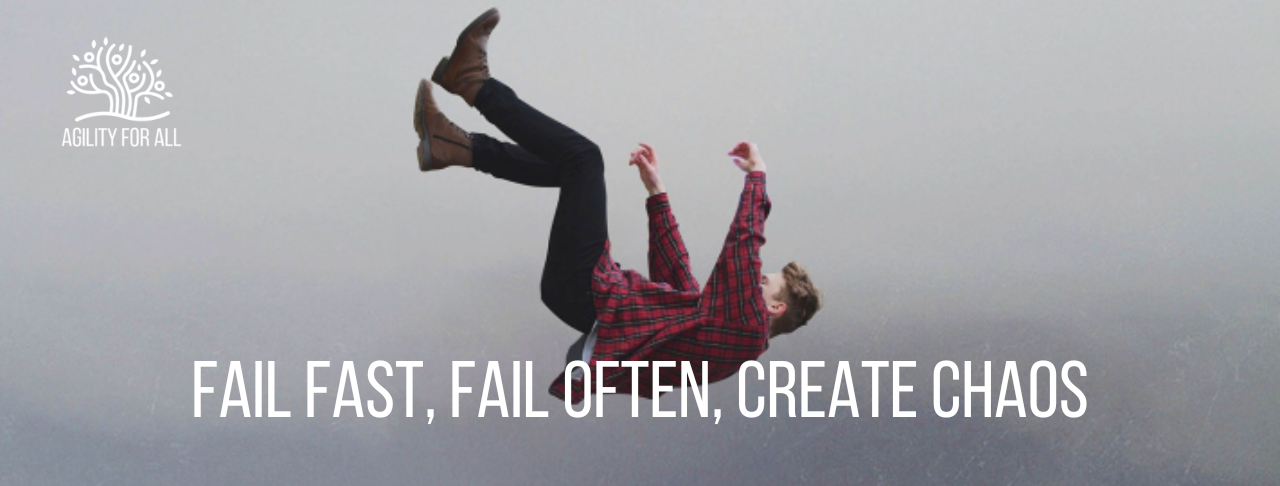Want an offsite in 2024 for your team? Or want to work on adapting your team culture? Schedule a call.

Fail Fast, Fail Often, Create Chaos
17/03/2021
In the Agile community we throw around the phrases “Fail Fast” or “Fail Fast, Fail Often” as if they are a badge of honor. And while I definitely encourage the acceptance of failure and the incorporation of it into the culture of the organization, it is not what people interpret it to be. What it means is that we need to be open to the idea of failure. That failing is not a punishment or will get someone banished to the archives never to be promoted or offered another opportunity. However, I have seen organizations jump on the fail fast bandwagon (and you all know how I feel about buzzwords) and swing the pendulum like a carnival ride in the complete opposite direction.
This creates an unstable environment
What this creates is an unstable environment. It creates one that produces constant change and chaos and while we support change, not at the expense of value-based progress. What we do want “fail fast” to mean is an understanding that we do not have to latch onto an idea and stay with it come hell or high water because we have approved the idea and there is no backing down now. What we do want “fail fast” to mean is that in the fabric of the organization we recognize that not all ideas will be successful ideas and we are going to recognize when they are not working and course correct quickly.
We must be open to failure
We must be open to failure. But when we are open to failure it means we use it as a tool for learning from our mistakes and continually evolving. We do not chastise someone for having an idea that didn’t pan out. We don’t then refuse to listen to another thing that person has to say because they got it wrong last time.
We use failure as an opportunity to try new and different things to solve the problem we are trying to solve rather than apply a one size fits all solution that may not work for this particular instance. We use failure as a way for the team to constantly evolve and develop higher performance through collaboration and experimentation.
In the past I have done several videos on this through our Lives that are now on YouTube which you can watch on replay. In fact, the discussion in yesterday’s Live was on the very topic exploring whether or not it is OK to fail. In our 14-day challenge we asked participants to draw what failure looks like at their organization with the intent of literally drawing out problem areas that create unsafe spaces and inhibit innovation. This is one of the most difficult concepts for organizations to conquer, steeped in part by the ingrained leadership culture that we must always make the right decisions at the right times. We have made failure a very bad word that will ensure the end of someone’s career as a C-suite executive. So it is no wonder then that it is the most difficult habit to break.
But how do we change? Where do we start?
So how do we change this premise and make sure we don’t swing completely into the opposite arena and create an environment where teams are unsure of their footing? We start with a ensuring we have an agile mindset and we use the tools we were given:
-
Inspect and Adapt
-
Transparency
-
Iterations
-
Continuous Improvement
-
And yes failure through experimentation.
As leaders, we demonstrate these traits by involving all levels of the organization in not only decision making, but in recognizing the need for corrective action. We don’t issue edicts dictating what is next and how it will be done. Instead, we create an environment that is a psychologically safe space that fosters leadership from top to bottom and allows for collaborative team members to speak their truth to help with innovation and creativity. We acknowledge that things will go wrong, but we also acknowledge that we are going to own those failures and recover from them quickly.
We don’t throw the organization into turmoil
We are not going to throw the organization into turmoil by not taking decisive action when needed and keeping the teams guessing as to what is next. We are not going to encourage customers to constantly change their minds and vacillate wildly from one idea to the next without any kind of validation. And we are not going to criticize the teams for not having perfect outcomes every time. At the end of the day, we want to always create value for our customers. To do that, we need to involve them, trust our experts to do the right thing at the right time, and continually evolve the teams to higher performance not through chaos and constant shifting and not throw impossible workload demands, but through sound experimentation and innovation brought on by a safe space to work and a collaborative spirit.
Want to learn more?
For more information on all of these topics, check out all of our blogs and follow us on the socials where we present new content almost every day. And if there is a topic that you want to explore more, contact us to pitch an idea. We are always looking for new ideas to share with our readers.
Learn More
About the Author:
 INDRA A. BOOKS
INDRA A. BOOKS
With 25 years of award-winning coaching and leadership experience, Indra has a passion for helping companies, teams, and individuals bring about meaningful, goal-oriented transformations which are firmly grounded in Agile principles. She currently works from Spain with companies around the world to achieve sustainable growth based on true agility; helping them make value-based changes and see results with high-performing teams.
Connect with us
 |
 |
 |
Search

WELCOME TO THE AGILITY FOR ALL LEARNING PORTAL
We offer loads of free information here in the blog and also in our
resource library
Agility for All provides coaching, consulting, and training programs. In addition to specialized consulting, you have the option to choose from:
- group coaching programs
- masterclasses
- 1-week intensive offsites
Our programs are designed to help your organization to:
- Maximize Employee Engagement
- Foster Self-Organization
- Encourage Innovation
- Attain Higher Performance
- Be More Agile
